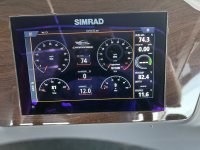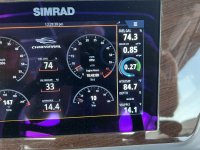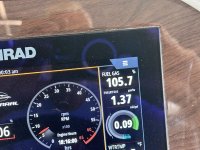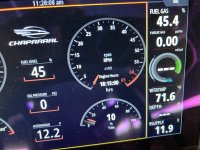I have a 2024 Chaparral 21’ SSI with I/O. The fuel gauge has never worked correctly on the Simrad display. I took it back to the dealer at the end of last season and they claimed to fix it but it’s not clear they really did anything. They pulled the tank sensor and found the tank almost empty but it wasn’t reading that low. This year I was sitting on my boat lift with a very slight rocking from some very small waves and the tank reading was going from 46% to 54 & 54.3% to 63% and occasionally up to 74%. It was always those numbers with nothing in between. I added approximately 6 gallons of gas to the 40 gallon tank and the readings would then bounce back and forth to the readings of 74.3% and 105.7%. Once underway it would display a constant 105.7%. If I raise the boat completely out of the water so that it is very still I can get a constant reading. 6 gallons is only 15% of a 40 gallon tank and should have only made that much difference in the reading instead of jumping tp 105.7% so I have no idea how much gas is in the boat. I’ve had very little support from the dealer this year. They did switch out the fuel sensor with no change in symptoms. They did at last contact Chaparral and Chaparral told them to change the fuel display to a bar graph. As expected that did nothing to help with the problem. The bar graph is just a graphical display of the percent reading and it jumped around just like the percent display. Any suggestions on where to look for the problem? Thanks
You are using an out of date browser. It may not display this or other websites correctly.
You should upgrade or use an alternative browser.
You should upgrade or use an alternative browser.
2024 Chaparral SSI fuel gauge not reading correctly
- Thread starter MHM
- Start date
Iggy
Active member
I am not surprised at all. I have had about 6 small boat from different builders with the same problem. The only 2 ways to get a good reading is.
1. have the boat motionless for 2 or more minutes.
2. add baffles to the tank to stop the gas from going side to side in the tank.
What I always did with each boat... I will take my last small boat. On a full tank and running at 2300 to 2400RPMs. I had 4hrs of fuel. After 3hrs, I always ether found a fuel dock or I was back in my slip. That give me a margin of safety to never run out. This was a little bit of trail and error to figure this out.
On my first boat I went out on what I thought to have plenty of fuel. On a good day I did. A small storm hit and I had to go slow causing me to use more fuel. I just made it back with a very empty tank. That was a learning experience!
1. have the boat motionless for 2 or more minutes.
2. add baffles to the tank to stop the gas from going side to side in the tank.
What I always did with each boat... I will take my last small boat. On a full tank and running at 2300 to 2400RPMs. I had 4hrs of fuel. After 3hrs, I always ether found a fuel dock or I was back in my slip. That give me a margin of safety to never run out. This was a little bit of trail and error to figure this out.
On my first boat I went out on what I thought to have plenty of fuel. On a good day I did. A small storm hit and I had to go slow causing me to use more fuel. I just made it back with a very empty tank. That was a learning experience!
SST
Well-known member
In the beginning my gauge and sending unit were poor. Gauge was and still is OEM. Eventually bought a new sending unit but getting it screwed and sealed to the tank became a problem. Eventually I got it right and I’ve been happy with its accuracy for more than 11 years. The system is accurate within 2 gallons.
For example: If I’m sitting in my slip at half a tank, the gauge will show half. But if I’m accelerating the gauge will show maybe 7/8th of a tank as all the fuel will push back to the stern. Plus, being properly trimmed, the bow is higher than dead rise so fuel will push back also.
If I top the tank off (80 gal) the gauge will be pegged to FULL regardless if I’m moving or not. It will take roughly 3 hours (1/4 tank) for the needle to start moving. After that, the gauge becomes accurate.
I’m operating on steam gauges where you’re operating with glass so “things” might be different.
For example: If I’m sitting in my slip at half a tank, the gauge will show half. But if I’m accelerating the gauge will show maybe 7/8th of a tank as all the fuel will push back to the stern. Plus, being properly trimmed, the bow is higher than dead rise so fuel will push back also.
If I top the tank off (80 gal) the gauge will be pegged to FULL regardless if I’m moving or not. It will take roughly 3 hours (1/4 tank) for the needle to start moving. After that, the gauge becomes accurate.
I’m operating on steam gauges where you’re operating with glass so “things” might be different.
I ran mine by hrs. I started a log to find an average, which was about 6 gal per hr. I have an 88 gal tank. So the longest I would run without filling up was 10 hrs. Today even with all my other gauges for safety I like hrs. That gave me a fudge factor of 8 gal per hr.
I was not comfortable with 7, so I went with 8.Calculating by hours has been in my blood since long before I started flying.
My last calculation on fuel consumption was 7gph.
The difference between flying and boating is when you only have 1 tank and you empty it, you are drifting.
Last edited:
You will need more than flares if you are headed to those falls.Even though the calculation came to 7...I actually overestimate to using 10. Fudging the numbers in my favor. Better to have to much fuel than not enough. If I run out of gas I may drift but then I have to deal with Niagara Falls. That's a good reason to carry flares.

Along with a big heavy anchor or 2A VHF might be better.
Makes me glad that I am clear at the other end of the lake.
Thanks for your reply’s. I don’t see adding baffles as a practical solution and while I can certainly keep track of hours that would not be preferred. Plus I don’t trust the baseline of a still boat since I can add say 10 gallons of gas or 25% of the capacity and the gauge will then show 35 to 40% more gas in the tank. Do I believe before or after?
I also understand that a boat underway will push the gas towards the back of the tank and change the reading. I’ve had 4 small boats before and never had this kind of problem before. However they were all analog gauges and this is a digital Simrad display.
Certainly there is enough smarts in the Simrad to make a much more accurate reading by tracking fuel usage and reading the sensor without it bouncing all over the place. I would have expected Chaparral to setup the Simrad to give fairly accurate readings and not expect us all to keep track of hours and mentally calculate how much gas is in the boat every time we go out? The dealer agrees the boat is not reading correctly but they seem to have no clue and Chaparral doesn’t seem to be helping. I paid a lot of money for this boat and would like a gas gauge that is reasonably accurate.
I also understand that a boat underway will push the gas towards the back of the tank and change the reading. I’ve had 4 small boats before and never had this kind of problem before. However they were all analog gauges and this is a digital Simrad display.
Certainly there is enough smarts in the Simrad to make a much more accurate reading by tracking fuel usage and reading the sensor without it bouncing all over the place. I would have expected Chaparral to setup the Simrad to give fairly accurate readings and not expect us all to keep track of hours and mentally calculate how much gas is in the boat every time we go out? The dealer agrees the boat is not reading correctly but they seem to have no clue and Chaparral doesn’t seem to be helping. I paid a lot of money for this boat and would like a gas gauge that is reasonably accurate.
You could go the way that we use to do it. If you have a have a sending unit on the tank remove the sending unit and replace it with a cover with a screw on cap.
Then get a dipstick with markings on it.
They do make inline flo meters, that you can add, that is what I have and it is pretty accurate.
I still do hours as a backup also.
Then get a dipstick with markings on it.
They do make inline flo meters, that you can add, that is what I have and it is pretty accurate.
I still do hours as a backup also.
Iggy
Active member
Yep,You could go the way that we use to do it. If you have a have a sending unit on the tank remove the sending unit and replace it with a cover with a screw on cap.
Then get a dipstick with markings on it.
They do make inline flo meters, that you can add, that is what I have and it is pretty accurate.
I still do hours as a backup also.
As I mentioned, a in line fuel sensor and the simrad unit should display GPH rate. AND with that I think it will tell you how much fuel is left.
SST
Well-known member
I did buy a new larger anchor. So far, it holds me in position. It's about 7lbs lighter with the heavy chain still attached. The Navy 20lb anchor is on its own line now. Having the heavy chain with the Navy anchor was absolutely murderous on my lower back.Along with a big heavy anchor or 2
Makes me glad that I am clear at the other end of the lake.
I know what you mean, that is why I installed a windlass.Chain is key for a good anchor rode. For your back, I would buy a windless.
I don't jump over my windshield very well any more. or climb through the hatch either.




